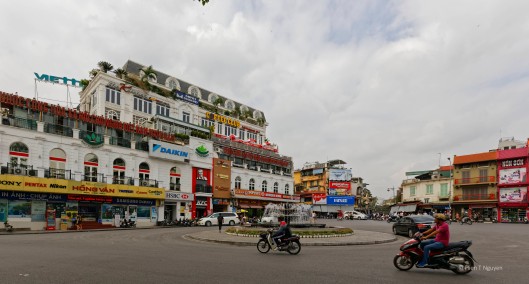Tags
In 1954, my family was among the one million North Vietnamese who left to go to South Việt Nam rather than live under communism. Sixty two years later, I flew back to Hà Nội, the capital of a unified country under a communist regime, with the ubiquitous red flag with one yellow star flying on government buildings, public monuments and even some temples of worship.
This year, the number of tourists visiting Việt Nam may reach 10 million, and the economic impact can be seen readily in Hà Nội. We stayed in the Old Quarter area, in a hotel only a block away from Hoàn Kiếm (Returned Sword) lake. According to legend, a turtle from the lake brought a sword to King Lê Lợi. He used it to liberate the country from Chinese rule, and when he was done with that task, returned the sword to the turtles in the lake.
Hoàn Kiếm lake was visible from the top floor of our hotel.
The Turtle Tower was on a small island at one end of the lake. Once in a while, turtles can still be seen climbing up on the island to sun themselves. I saw them at least once in the 50’s when I was small, but not this time.
At night, the tower was brightly lit, the center of attraction for the lake area.
As can be seen in the above pictures, there has been a lot of building around the lake. Even the Old Quarter with its narrow and winding streets has had a lot of new construction in the form of several storied and narrow hotels rising up where row houses used to be.
Tourists, especially backpackers, love the Old Quarter which has added some Western flavor to the old French colonial buildings.
Traffic in Hà Nội, a city of almost 8 million people now, rivals that of Sài Gòn in congestion and common disregard for traffic laws, despite government billboards urging all to obey them.
In the city northern area, another famous and much larger lake is Hồ Tây, where one can see some of the high-rise and villas built in more recent years. Real estate prices there are sky high.
One important feature of Hồ Tây was Trấn Quốc pagoda built in the 6th century, and still quite well preserved
Back at Hoàn Kiếm lake, I was able to capture some shots of daily life.















Your capture of Turtle Tower at night is gorgeous, Hien. And I love the bike lady and her veggies capture, amazing balance she has! I feel privileged to follow you along on your return to your homeland. I am glad you were able to take this journey!
LikeLiked by 1 person
Donna, I am glad you like this series on Viet Nam.
LikeLiked by 1 person
Beautiful pictures! the vegetable lady is my favorite.
LikeLiked by 1 person
She’s my favorite too. Thank you Tiny!
LikeLiked by 1 person
I love all your photos of Việt Nam…the colours are spectacular 🙂
LikeLiked by 1 person
Thank you very much, Elle!
LikeLiked by 1 person
Very nice series. The image looking down on the bicycle with all of the vegetables is very colorful. It also gives a great perspective.
LikeLiked by 1 person
Thank you Tim!
LikeLike
You’re welcome
LikeLike
I loved the legend of the turtle, and I guess the tower is a shrine of some kind to the turtle?
Once again, I’m struck by the mixture of old and new.
LikeLiked by 1 person
The tower is a shrine to the turtles, and that small island is a place for them to come up once in a while.
LikeLike
Beautiful photos. What a great view you had from your hotel.
LikeLiked by 1 person
Thanks Katelon. That view is from one room on the top floor. We did not stay there, but I asked the hotel to let me take some photos from its windows.
LikeLiked by 1 person
wonderfully expressed return!
i enjoyed my visits
there, too 🙂
LikeLiked by 1 person
Thank you!
LikeLike
Interesting glad that they have kept some of the old buildings – how sad about the lack of turtles
LikeLiked by 1 person
Diana, the turtles could be a few hundred years old. I am told that they still come up, but not as often as years ago.
LikeLike
The last turtle actually died a while ago, right before the election. They said it was a bad omen for the Party haha.
LikeLiked by 1 person
Thank you for commenting and providing this information.
LikeLike
Really great posts, looks very beautiful, thanks for sharing
LikeLiked by 1 person
Thank you, Jim, for visiting and commenting!
LikeLike